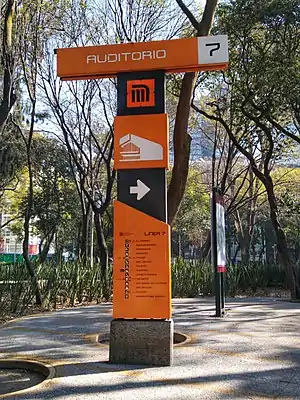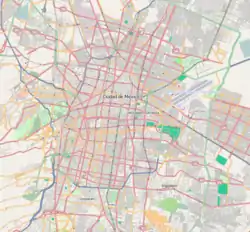| STC rapid transit | ||||||||||||||||||||||||||||||||||||||||||||||||||||||||||||||||||||||||||||||||||||||||||||||||||||||||||||||||||||||||
 Metro Auditorio entrance sign | ||||||||||||||||||||||||||||||||||||||||||||||||||||||||||||||||||||||||||||||||||||||||||||||||||||||||||||||||||||||||
| General information | ||||||||||||||||||||||||||||||||||||||||||||||||||||||||||||||||||||||||||||||||||||||||||||||||||||||||||||||||||||||||
| Location | Paseo de la Reforma Polanco, Miguel Hidalgo Mexico City Mexico | |||||||||||||||||||||||||||||||||||||||||||||||||||||||||||||||||||||||||||||||||||||||||||||||||||||||||||||||||||||||
| Coordinates | 19°25′32″N 99°11′31″W / 19.425498°N 99.191995°W | |||||||||||||||||||||||||||||||||||||||||||||||||||||||||||||||||||||||||||||||||||||||||||||||||||||||||||||||||||||||
| Operated by | Sistema de Transporte Colectivo (STC) | |||||||||||||||||||||||||||||||||||||||||||||||||||||||||||||||||||||||||||||||||||||||||||||||||||||||||||||||||||||||
| Line(s) | ||||||||||||||||||||||||||||||||||||||||||||||||||||||||||||||||||||||||||||||||||||||||||||||||||||||||||||||||||||||||
| Platforms | 2 side platforms | |||||||||||||||||||||||||||||||||||||||||||||||||||||||||||||||||||||||||||||||||||||||||||||||||||||||||||||||||||||||
| Tracks | 2 | |||||||||||||||||||||||||||||||||||||||||||||||||||||||||||||||||||||||||||||||||||||||||||||||||||||||||||||||||||||||
| Connections | ||||||||||||||||||||||||||||||||||||||||||||||||||||||||||||||||||||||||||||||||||||||||||||||||||||||||||||||||||||||||
| Construction | ||||||||||||||||||||||||||||||||||||||||||||||||||||||||||||||||||||||||||||||||||||||||||||||||||||||||||||||||||||||||
| Structure type | Underground | |||||||||||||||||||||||||||||||||||||||||||||||||||||||||||||||||||||||||||||||||||||||||||||||||||||||||||||||||||||||
| Platform levels | 1 | |||||||||||||||||||||||||||||||||||||||||||||||||||||||||||||||||||||||||||||||||||||||||||||||||||||||||||||||||||||||
| Parking | No | |||||||||||||||||||||||||||||||||||||||||||||||||||||||||||||||||||||||||||||||||||||||||||||||||||||||||||||||||||||||
| Bicycle facilities | No | |||||||||||||||||||||||||||||||||||||||||||||||||||||||||||||||||||||||||||||||||||||||||||||||||||||||||||||||||||||||
| Accessible | Yes | |||||||||||||||||||||||||||||||||||||||||||||||||||||||||||||||||||||||||||||||||||||||||||||||||||||||||||||||||||||||
| Other information | ||||||||||||||||||||||||||||||||||||||||||||||||||||||||||||||||||||||||||||||||||||||||||||||||||||||||||||||||||||||||
| Status | In service | |||||||||||||||||||||||||||||||||||||||||||||||||||||||||||||||||||||||||||||||||||||||||||||||||||||||||||||||||||||||
| History | ||||||||||||||||||||||||||||||||||||||||||||||||||||||||||||||||||||||||||||||||||||||||||||||||||||||||||||||||||||||||
| Opened | 23 August 1985 | |||||||||||||||||||||||||||||||||||||||||||||||||||||||||||||||||||||||||||||||||||||||||||||||||||||||||||||||||||||||
| Passengers | ||||||||||||||||||||||||||||||||||||||||||||||||||||||||||||||||||||||||||||||||||||||||||||||||||||||||||||||||||||||||
| 2022 | 5,474,627[1] | |||||||||||||||||||||||||||||||||||||||||||||||||||||||||||||||||||||||||||||||||||||||||||||||||||||||||||||||||||||||
| Rank | 32/195[1] | |||||||||||||||||||||||||||||||||||||||||||||||||||||||||||||||||||||||||||||||||||||||||||||||||||||||||||||||||||||||
| Services | ||||||||||||||||||||||||||||||||||||||||||||||||||||||||||||||||||||||||||||||||||||||||||||||||||||||||||||||||||||||||
| ||||||||||||||||||||||||||||||||||||||||||||||||||||||||||||||||||||||||||||||||||||||||||||||||||||||||||||||||||||||||
| ||||||||||||||||||||||||||||||||||||||||||||||||||||||||||||||||||||||||||||||||||||||||||||||||||||||||||||||||||||||||
| Location | ||||||||||||||||||||||||||||||||||||||||||||||||||||||||||||||||||||||||||||||||||||||||||||||||||||||||||||||||||||||||
 Location within Mexico City | ||||||||||||||||||||||||||||||||||||||||||||||||||||||||||||||||||||||||||||||||||||||||||||||||||||||||||||||||||||||||
| Area map | ||||||||||||||||||||||||||||||||||||||||||||||||||||||||||||||||||||||||||||||||||||||||||||||||||||||||||||||||||||||||
Auditorio (Spanish: Estación Auditorio) is a Mexico City Metro station located on line 7.[2][3] It is one of the main metro gateways (along with Metro Polanco) to the chic and business-related neighborhood, Polanco.[2] The entrances to the station are on Paseo de la Reforma, one of the main thoroughfares in Mexico City.
Its symbol depicts the façade of the Auditorio Nacional (English: National Auditorium), which is just above the station.[2][3] The auditorium is one of the main venues for concerts, shows and entertainment in the city, so almost every weekend night, this station is used by the attendants to the events.[2] The station opened on 23 August 1985.[4]
General information
This station is also frequently used by tourists because of its proximity to many landmarks of the city, such as Chapultepec.[2] Outside the station, just in front of the Auditorio Nacional, is the main station of the Turibus, a double-deck bus that runs a touristic route that goes from Chapultepec Park to the Historic Center along Reforma.
During weekdays, this station is also one of the busiest ones of the network because it is an entrance to the business, office and financial area in Polanco.[5] Outside the station there is also one of the main microbus stops in the area; these microbuses transport people coming from the metro to other business and commercial zones in the city like northern Polanco, Palmas, Santa Fe, Lomas de Chapultepec and Satélite.
During rush hour, due to the large mass of people taking these buses outside the metro station and to the poor infrastructure of the microbus stops, heavy traffic is originated in this part of Paseo de la Reforma. Criticism has also been made to the layout of this metro station (among others of Line 7) because the heavy flows of people are not well managed; during rush hours flows of people walking in different directions often face each other causing a decrease in the speed of pedestrian traffic. Other problems concern the bottlenecks at bridges, narrow tunnels, escalators, and normal stairs due to low capacity.
Ridership
| Annual passenger ridership | |||||
|---|---|---|---|---|---|
| Year | Ridership | Average daily | Rank | % change | Ref. |
| 2022 | 8,199,311 | 22,463 | 32/195 | +49.77% | [1] |
| 2021 | 5,474,627 | 14,998 | 41/195 | +0.90% | [6] |
| 2020 | 5,425,779 | 14,824 | 51/195 | −56.61% | [7] |
| 2019 | 12,503,639 | 34,256 | 29/195 | +6.92% | [8] |
| 2018 | 11,693,911 | 32,038 | 37/195 | −3.32% | [9] |
| 2017 | 12,096,093 | 33,139 | 31/195 | −1.00% | [10] |
| 2016 | 12,218,504 | 33,383 | 33/195 | +6.06% | [11] |
| 2015 | 11,520,226 | 31,562 | 41/195 | +4.13% | [12] |
| 2014 | 11,063,269 | 30,310 | 42/195 | +1.50% | [13] |
| 2013 | 10,900,220 | 29,863 | 48/195 | −0.92% | [14] |
| 2012 | 11,000,976 | 30,057 | 45/195 | +11.95% | [15] |
| 2011 | 9,826,414 | 26,921 | 59/175 | +12.46% | [16] |
| 2010 | 8,737,991 | 23,939 | 53/175 | – | [17] |
Nearby
- Auditorio Nacional, concert and entertainment venue.
- Campo Marte, equestrian and military facility.
- Bosque de Chapultepec, city park and zoo.
- Centro Cultural del Bosque, theater.
- Jardín Winston Churchill, small garden and park which includes a statue of Winston Churchill.
- National Museum of Anthropology, the largest and most visited museum of Mexico
Gallery
 Pedestrian underpass for Metro Auditorio with displays of metro systems around the world.
Pedestrian underpass for Metro Auditorio with displays of metro systems around the world.
References
- 1 2 3 "Afluencia de estación por línea 2022" [Station traffic per line 2022] (in Spanish). Sistema Transporte Colectivo Metro. 2023. Archived from the original on 5 March 2023. Retrieved 5 March 2023.
- 1 2 3 4 5 "Auditorio" (in Spanish). Archived from the original on 14 June 2011. Retrieved 1 August 2011.
- 1 2 Archambault, Richard. "Auditorio » Mexico City Metro System". Retrieved 1 August 2011.
- ↑ Schwandl, Robert. "Opening Dates for Mexico City's Subway". Retrieved 1 August 2011.
- ↑ "Polanco CirculoVivo". Archived from the original on 3 August 2011. Retrieved 1 August 2011.
- ↑ "Afluencia de estación por línea 2021" [Station traffic per line 2021] (in Spanish). Sistema Transporte Colectivo Metro. 2020. Archived from the original on 7 March 2022. Retrieved 7 March 2022.
- ↑ "Afluencia de estación por línea 2020" [Station traffic per line 2020] (in Spanish). Sistema Transporte Colectivo Metro. 2021. Archived from the original on 21 June 2021. Retrieved 21 June 2021.
- ↑ "Afluencia de estación por línea 2019" [Station traffic per line 2019] (in Spanish). Sistema Transporte Colectivo Metro. 2020. Archived from the original on 8 April 2020. Retrieved 3 May 2020.
- ↑ "Afluencia de estación por línea 2018" [Station traffic per line 2018] (in Spanish). Sistema Transporte Colectivo Metro. 2019. Archived from the original on 6 June 2019. Retrieved 7 April 2020.
- ↑ "Afluencia de estación por línea 2017" [Station traffic per line 2017] (in Spanish). Sistema Transporte Colectivo Metro. 2019. Archived from the original on 3 May 2020. Retrieved 3 May 2020.
- ↑ "Afluencia de estación por línea 2016" [Station traffic per line 2016] (in Spanish). Sistema Transporte Colectivo Metro. 2017. Archived from the original on 3 May 2020. Retrieved 3 May 2020.
- ↑ "Afluencia de estación por línea 2015" [Station traffic per line 2015] (in Spanish). Sistema Transporte Colectivo Metro. 2016. Archived from the original on 3 May 2020. Retrieved 6 May 2020.
- ↑ "Afluencia de estación por línea 2014" [Station traffic per line 2014] (in Spanish). Sistema Transporte Colectivo Metro. 2015. Archived from the original on 3 May 2020. Retrieved 6 May 2020.
- ↑ "Afluencia de estación por línea 2013" [Station traffic per line 2013] (in Spanish). Sistema Transporte Colectivo Metro. 2014. Archived from the original on 3 May 2020. Retrieved 6 May 2020.
- ↑ "Afluencia de estación por línea 2012" [Station traffic per line 2012] (in Spanish). Sistema Transporte Colectivo Metro. 2013. Archived from the original on 3 May 2020. Retrieved 6 May 2020.
- ↑ "Afluencia de estación por línea 2011" [Station traffic per line 2011] (in Spanish). Sistema Transporte Colectivo Metro. 2012. Archived from the original on 7 May 2020. Retrieved 6 May 2020.
- ↑ "Afluencia de estación por línea 2010" [Station traffic per line 2010] (in Spanish). Sistema Transporte Colectivo Metro. 2011. Archived from the original on 7 May 2020. Retrieved 6 May 2020.
External links
 Media related to Auditorio (station) at Wikimedia Commons
Media related to Auditorio (station) at Wikimedia Commons- "Metro Auditorio". Atlas Obscura.